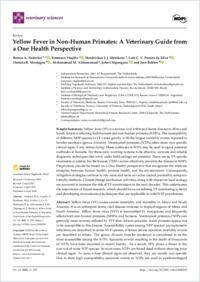Yellow fever in non-human primates : a veterinary guide from a one health perspective
- Nederlof, Remco A. Independent Researcher, Bergambacht, The Netherlands
- Virgilio, Tommaso ORCID Institute for Research in Biomedicine (IRB), Faculty of Biomedical Sciences, Università della Svizzera italiana, Switzerland
- Stemkens, Hendrickus J. J. Stichting Vogelpark Avifauna, Alphen aan den Rijn, The Netherlands
- Pereira da Silva, Luiz C. C. Institute of Science and Technology in Biomodels, Fiocruz, Rio de Janeiro, Brazil
- Montagna, Daniela R. Institute of Biological Chemistry and Biophysics (UBA-CONICET), Buenos Aires, Argentina
- Abdussamad, Abdussamad M. Faculty of Veterinary Medicine, Bayero University, Kano, Nigeria
- Chipangura, John Faculty of Veterinary Science, University of Pretoria, Onderstepoort, South Africa
- Bakker, Jaco Animal Science Department, Biomedical Primate Research Centre, Rijswijk, The Netherlands
- 2025
Published in:
- Veterinary sciences. - 2025, vol. 12, no. 4, p. 339
One health
Yellow fever
Vector-borne
Viral disease
Neotropical primate
Zoonotic
Arbovirus
Mortality
Howler monkey
Prevention
English
Yellow fever (YF) causes severe morbidity and mortality in Africa and South America. It is an arthropod-borne viral disease endemic to tropical regions of Africa and South America. Yellow fever virus (YFV) is transmitted by mosquitoes and frequently affects both non-human primates (NHPs) and humans. Neotropical primates (NTPs) are generally more severely afflicted by YFV than African primates. Asian primates appear not to be susceptible to this disease. Susceptibility varies among NTP species: asymptomatic infections are described in some NTP species, whereas severe epizootic mortality events are described in others. The genus Alouatta (howler monkeys) is considered to be the most susceptible among the NTPs. Epizootic events resulting in the death of thousands of NTPs have been recorded in recent history. As a result, YFV poses a threat to the survival of some NTP species. In most cases, NTPs are found dead without showing prior clinical signs. In cases where clinical signs are observed, they are mostly non-specific. Due to their high susceptibility, epizootic events in NTPs are used as epidemiological predictors for human YF outbreaks. YFV infection may be diagnosed by means of virus isolation, reverse transcription polymerase chain reaction, serology, histopathology, or immunohistochemistry. Animals that survive the disease develop neutralizing antibodies to YFV. Currently, no specific treatment is available. Sustained YF control strategies must rely on surveillance and accurate diagnostics to allow for early detection of outbreaks and rapid implementation of control measures. Prophylaxis should be based on a One Health perspective that recognizes the intricate interplay between human health, primate health, and the environment. Vaccines for YF are available, with the human 17DD vaccine effectively preventing disease in primates. However, mitigation strategies continue to rely more and more on vector control, preferably using eco-friendly methods. Climate change and human activities, and their impact on local ecology, are assumed to increase the risk of YF transmission in the next decades.
- Collections
- Language
-
- English
- Classification
- Medicine
- License
- Open access status
- gold
- Identifiers
-
- DOI 10.3390/vetsci12040339
- ARK ark:/12658/srd1332087
- Persistent URL
- https://n2t.net/ark:/12658/srd1332087
Statistics
Document views: 56
File downloads:
- Virgilio_2025_MDPI_vetsci_Yellow fever: 24
